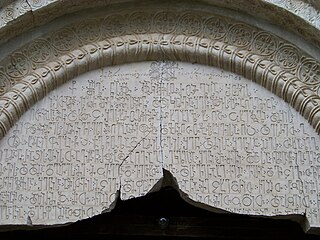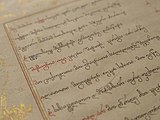Related Research Articles

Unicode, formally The Unicode Standard, is a text encoding standard maintained by the Unicode Consortium designed to support the use of text written in all of the world's major writing systems. Version 15.1 of the standard defines 149813 characters and 161 scripts used in various ordinary, literary, academic, and technical contexts.

The Georgian scripts are the three writing systems used to write the Georgian language: Asomtavruli, Nuskhuri and Mkhedruli. Although the systems differ in appearance, their letters share the same names and alphabetical order and are written horizontally from left to right. Of the three scripts, Mkhedruli, once the civilian royal script of the Kingdom of Georgia and mostly used for the royal charters, is now the standard script for modern Georgian and its related Kartvelian languages, whereas Asomtavruli and Nuskhuri are used only by the Georgian Orthodox Church, in ceremonial religious texts and iconography.
Combining Diacritical Marks is a Unicode block containing the most common combining characters. It also contains the character "Combining Grapheme Joiner", which prevents canonical reordering of combining characters, and despite the name, actually separates characters that would otherwise be considered a single grapheme in a given context. Its block name in Unicode 1.0 was Generic Diacritical Marks.
Specials is a short Unicode block of characters allocated at the very end of the Basic Multilingual Plane, at U+FFF0–FFFF. Of these 16 code points, five have been assigned since Unicode 3.0:
The Unicode Standard assigns various properties to each Unicode character and code point.
CJK Symbols and Punctuation is a Unicode block containing symbols and punctuation used for writing the Chinese, Japanese and Korean languages. It also contains one Chinese character.
Cyrillic is a Unicode block containing the characters used to write the most widely used languages with a Cyrillic orthography. The core of the block is based on the ISO 8859-5 standard, with additions for minority languages and historic orthographies.

Greek and Coptic is the Unicode block for representing modern (monotonic) Greek. It was originally also used for writing Coptic, using the similar Greek letters in addition to the uniquely Coptic additions. Beginning with version 4.1 of the Unicode Standard, a separate Coptic block has been included in Unicode, allowing for mixed Greek/Coptic text that is stylistically contrastive, as is convention in scholarly works. Writing polytonic Greek requires the use of combining characters or the precomposed vowel + tone characters in the Greek Extended character block.
Coptic is a Unicode block used with the Greek and Coptic block to write the Coptic language. Prior to version 4.1 of the Unicode Standard, the "Greek and Coptic" block was used exclusively to write Coptic text, but Greek and Coptic letter forms are contrastive in many scholarly works, necessitating their disunification. Any specifically Coptic letters in the Greek and Coptic block are not reproduced in the Coptic Unicode block.
Georgian Supplement is a Unicode block containing characters for the ecclesiastical form of the Georgian script, Nuskhuri. To write the full ecclesiastical Khutsuri orthography, the Asomtavruli capitals encoded in the Georgian block.
Myanmar is a Unicode block containing characters for the Burmese, Mon, Shan, Palaung, and the Karen languages of Myanmar, as well as the Aiton and Phake languages of Northeast India. It is also used to write Pali and Sanskrit in Myanmar.
Deseret is a Unicode block containing characters in the Deseret alphabet, which were invented by the Church of Jesus Christ of Latter-day Saints to write English. The Deseret block was derived from an earlier private use encoding in the ConScript Unicode Registry, like the Shavian and Phaistos Disc encodings. The block was added in version 3.1 of the Unicode Standard; the letters Oi and Ew, both uppercase and lowercase, were added in version 4.0.
Lisu is a Unicode block containing characters of the Fraser alphabet, which is used to write the Lisu language. This alphabet consists of glyphs resembling capital letters in the basic Latin alphabet in their standard form and turned.
Halfwidth and Fullwidth Forms is the name of a Unicode block U+FF00–FFEF, provided so that older encodings containing both halfwidth and fullwidth characters can have lossless translation to/from Unicode. It is the second-to-last block of the Basic Multilingual Plane, followed only by the short Specials block at U+FFF0–FFFF. Its block name in Unicode 1.0 was Halfwidth and Fullwidth Variants.
Ahom is a Unicode block containing characters used for writing the Ahom alphabet, which was used to write the Ahom language spoken by the Ahom people in Assam between the 13th and the 18th centuries.
Soyombo is a Unicode block containing characters from the Soyombo alphabet, which is an abugida developed by the monk and scholar Zanabazar (1635–1723) in 1686 to write Mongolian. It can also be used to write Tibetan and Sanskrit. In addition, this block includes the Soyombo symbol on the flag of Mongolia.
Mac OS Georgian is a character encoding for Mac OS created by Michael Everson for use in his fonts. It is not an official Mac OS character set.
Georgian Extended is a Unicode block containing Georgian Mtavruli letters that function as uppercase versions of their Mkhedruli counterparts in the Georgian block. Unlike all other casing scripts in Unicode, there is no title casing between Mkhedruli and Mtavruli letters, because Mtavruli is typically used only in all-caps text, although there have been some historical attempts at capitalization.
Old Sogdian is a Unicode block containing characters for a group of related, non-cursive Sogdian writing systems used to write historic Sogdian in the 3rd to 5th centuries CE.
Sogdian is a Unicode block containing characters used to write the Sogdian language from the 7th to 14th centuries CE.
References
- ↑ "Unicode character database". The Unicode Standard. Retrieved 2023-07-26.
- ↑ "Enumerated Versions of The Unicode Standard". The Unicode Standard. Retrieved 2023-07-26.
- ↑ "Unicode® 11.0.0". Unicode Consortium. June 5, 2018. Retrieved 8 June 2018.
